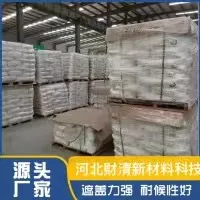
iul. . 04, 2025 11:05 Înapoi la listă
The Dual Function of Filling and Coloring with Titanium Dioxide in Rubber
Dioxid de titan (TiO₂) is a versatile material widely used in the rubber industry, serving both as a functional filler and a high-performance pigment. As a titanium dioxide manufacturer supplies this compound in various forms—such as titanium dioxide powder and titanium dioxide pigment—its applications in rubber products continue to expand. TiO₂ not only enhances the titanium dioxide color properties of rubber but also improves mechanical strength, durability, and UV resistance.

The Role of Titanium Dioxide Pigment in Rubber Coloring
One of the primary uses of titanium dioxide pigment in rubber is to provide a bright white color, which is essential for products like shoe soles, seals, and medical equipment. Unlike organic dyes, TiO₂ offers exceptional opacity and light-scattering properties, ensuring consistent titanium dioxide color without fading over time. The high refractive index of TiO₂ (approximately 2.7) makes it superior to other white pigments, such as zinc oxide or calcium carbonate, in achieving deep whiteness and brightness.
Additionally, titanium dioxide coating on rubber surfaces enhances aesthetic appeal while maintaining color stability under harsh environmental conditions. This is particularly important for automotive and outdoor rubber products exposed to sunlight, where UV degradation can cause discoloration. The photocatalytic properties of TiO₂ also help in self-cleaning applications, making it valuable for industrial and consumer rubber goods.
Titanium Dioxide Powder as a Reinforcing Filler in Rubber
Beyond its coloring function, titanium dioxide powder acts as an effective filler in rubber compounding. When incorporated into rubber matrices, TiO₂ improves tensile strength, abrasion resistance, and dimensional stability. The fine particle size of titanium dioxide powder ensures uniform dispersion within the rubber, enhancing mechanical properties without compromising flexibility.
Rubber manufacturers often use TiO₂ in combination with carbon black or silica to achieve a balance between reinforcement and coloration. Unlike carbon black, which darkens rubber, titanium dioxide pigment allows for the production of light-colored or white rubber products while still providing structural benefits. This dual functionality makes TiO₂ indispensable in industries requiring both durability and aesthetic control.
Processing Techniques for Incorporating Titanium Dioxide Coating in Rubber
The effective dispersion of titanium dioxide pigment in rubber depends on the compounding process. Two common methods are:
1. Dry Mixing
In this method, titanium dioxide powder is blended with raw rubber and other additives before vulcanization. High-shear mixing ensures uniform distribution, preventing agglomeration that could weaken the rubber structure.
2. Masterbatch Preparation
Some titanium dioxide manufacturers supply TiO₂ pre-dispersed in a rubber carrier (masterbatch), simplifying the mixing process. This approach enhances homogeneity and reduces dust exposure during production.
Once incorporated, titanium dioxide coating on the rubber surface can be further enhanced through calendaring or extrusion, ensuring a smooth finish with consistent pigmentation.
Environmental and Industrial Advantages of Using Titanium Dioxide in Rubber
The use of titanium dioxide pigment in rubber aligns with sustainability goals in several ways:
UV Protection: TiO₂ acts as a UV stabilizer, prolonging the lifespan of rubber products exposed to sunlight.
Reduced Material Waste: Its dual role as both filler and pigment minimizes the need for additional additives, streamlining production.
Recyclability: Rubber products containing TiO₂ can often be reprocessed without significant loss of quality, supporting circular economy initiatives.
However, challenges remain, particularly concerning nanoparticle emissions during manufacturing. Responsible titanium dioxide manufacturers are adopting advanced filtration and containment systems to mitigate workplace and environmental risks.
Innovations in Titanium Dioxide Applications for Rubber
As industries demand more sustainable and high-performance materials, research into modified titanium dioxide coating technologies is advancing. Key developments include:
Surface-Treated TiO₂: Chemically modified TiO₂ particles that improve compatibility with different rubber polymers.
Nano-Dioxid de titan: Ultra-fine particles offering enhanced reinforcement and UV-blocking capabilities.
Bio-Based Rubber Composites: Combining TiO₂ with natural rubber to create eco-friendly yet durable products.
These innovations ensure that titanium dioxide color and filler functions remain relevant in next-generation rubber applications.
Dioxid de titan plays a dual role in the rubber industry, serving as both a high-performance pigment and a reinforcing filler. From enhancing titanium dioxide color vibrancy to improving mechanical properties, TiO₂ is a critical component in modern rubber manufacturing. As titanium dioxide manufacturers continue to innovate, the future of TiO₂ in rubber looks promising, balancing performance, aesthetics, and environmental responsibility. By optimizing titanium dioxide coating techniques and exploring sustainable alternatives, the industry can further leverage TiO₂’s unique advantages while minimizing its ecological footprint.
In summary, the integration of titanium dioxide powder in rubber formulations exemplifies how a single additive can deliver multiple functional benefits, driving advancements in material science and industrial applications.
-
Using Titanium Dioxide to Reduce the Discoloration Rate of Rubber Products
ȘtiriJul.04,2025
-
The Influence of Titanium Dioxide on the Printability of Paper
ȘtiriJul.04,2025
-
The Environmental Impact of Using Titanium Dioxide in Paper Production
ȘtiriJul.04,2025
-
The Dual Function of Filling and Coloring with Titanium Dioxide in Rubber
ȘtiriJul.04,2025
-
Hidden Techniques for Improving Ink Adhesion with Titanium Dioxide
ȘtiriJul.04,2025
-
Comparison of the Application of Titanium Dioxide in Flexographic and Gravure Printing Inks
ȘtiriJul.04,2025
